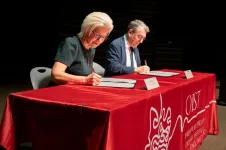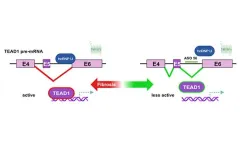POSTECH Professor Yong-Young Noh resolves two decades of oxide semiconductor challenges, which Is published in prestigious journal Nature
2024-04-26
(Press-News.org) Professor Yong-Young Noh from the Department of Chemical Engineering at Pohang University of Science and Technology (POSTECH), along with Dr. Ao Liu and Dr. Huihui Zhu, postdoctoral researchers from the Department of Chemical Engineering at POSTECH and now professors at the University of Electronic Science and Technology of China, Dr. Yong-Sung Kim from Korea Research Institute of Standards and Science, and Dr. Min Gyu Kim from the Pohang Accelerator Laboratory, collaborated on the development of a tellurium-selenium composite oxide semiconductor material. Their efforts led to the successful creation of a high-performance and highly stable p-type thin-film transistor (TFT). This research has been published online in Nature, a premier international scientific journal.
Semiconductors are used in almost every electronic device that people use such as cell phones, PCs, and automobiles. They can be classified into two main categories: crystalline and amorphous semiconductors. Crystalline semiconductors possess a well-ordered atomic or molecular structure while amorphous semiconductors lack such regularity. Consequently, amorphous semiconductors offer simpler fabrication methods and reduced costs compared to their crystalline counterparts. However, they typically exhibit inferior electrical performance.
Research progress on p-type amorphous semiconductors has been notably sluggish. Despite the widespread adoption of n-type amorphous oxide semiconductors, particularly those based on indium gallium zinc oxide (IGZO) in OLED displays and memory devices, the advancement of p-type oxide materials has been impeded by numerous inherent defects. This setback has hindered the development of n-p-type complementary bipolar semiconductors (CMOS), which serve as the cornerstone of electronic devices and integrated circuits. Achieving high-performance amorphous p-type oxide semiconductor devices has long been regarded as a near-impossible challenge, with academia facing two decades of unsuccessful attempts.
Nevertheless, a team of researchers led by POSTECH Professor Yong-Young Noh, has transformed the seemingly “impossible” into the “possible”.
Through their investigation, the team discovered that the charge of tellurium oxide, a rare earth metal, increases in oxygen-deficient environments. This phenomenon arises from the creation of an acceptor level capable of accommodating electrons in the absence of sufficient oxygen, thereby enabling the material to function as a p-type semiconductor. Building upon this insight, the team successfully engineered high-performance and exceptionally stable amorphous p-type oxide Thin-Film Transistors (TFTs) utilizing partially oxidized tellurium thin films and a tellurium-selenium composite oxide (Se:TeOx) incorporating selenium.
Experimental findings reveal that the team's TFTs exhibit the most impressive hole mobility (15 cm2V-1s-1) and on/off current ratio (106-107) ever reported for a p-type amorphous oxide TFT. These achievements nearly match the performance levels of conventional n-type oxide semiconductors (such as IGZOs), which have been extensively studied.
Furthermore, the team's TFTs demonstrated exceptional stability under varying external conditions including fluctuations in voltage, current, air, and humidity. Notably, uniform performance across all TFT components was observed when fabricated on wafers, affirming their suitability for reliable semiconductor devices applicable in industrial settings.
Professor Yong-Young Noh of POSTECH expressed optimism by saying, "This milestone holds significant implications for next-generation display technologies such as OLED TVs, VR, and AR devices as well as for research on low-power CMOS and DRAM memory." He added, "We anticipate its potential to drive substantial value creation across diverse industries."
The research was conducted with support from the National Semiconductor Laboratory Program and the Mid-Career Researcher Program of the National Research Foundation of Korea, and Samsung Display.
END
[Attachments] See images for this press release:


ELSE PRESS RELEASES FROM THIS DATE:
2024-04-26
Indigenous aquaculture systems in Hawaiʻi, known as loko iʻa or fishponds, can increase the amount of fish and fisheries harvested both inside and outside of the pond. This is the focus of a study published by a team of researchers at the University of Hawaiʻi at Mānoa Hawaiʻi Institute of Marine Biology (HIMB). Today, aquaculture supplies less than 1% of Hawaiʻi’s 70 million pounds of locally available seafood, but revitalization of loko i‘a has the potential to significantly increase locally available seafood.
According to historical accounts, loko ...
2024-04-26
The Okinawa Institute of Science and Technology (OIST) and France’s National Centre for Scientific Research (CNRS) have signed a letter of intent to work towards establishing an international research lab and agreeing on comprehensive academic collaboration.
The signing ceremony took place during the opening session of the OIST-CNRS Joint Symposium on West Pacific Marine Biology on April 23. Dr. Karin Markides, President and CEO, and Professor Vincent Laudet were among the speakers from OIST, and they were joined by representatives from CNRS, namely Dr. André ...
2024-04-26
In the last several decades, large forest fires have increasingly threatened communities across the Mediterranean. Climate change is expected to make these fires larger, hotter, and more dangerous in the future. But fire management lessons from the past could help to improve the resilience of local landscapes.
The latest research paper from environmental anthropologist and University of California, Santa Cruz Professor Andrew Mathews explores these issues in the Monte Pisano region of Central Italy. In particular, Mathews found that peasant women, who historically collected ...
2024-04-26
Living at higher altitudes in India is linked to an increased risk of stunted growth, with children living in homes 2000 metres or more above sea level 40% more at risk than those living 1000 metres below, finds research published in the open access journal BMJ Nutrition Prevention & Health.
Children living in rural areas seem to be the most vulnerable, prompting the researchers to advocate prioritising nutritional programmes in hilly and mountainous regions of the country.
Despite ...
2024-04-26
A healthy liver filters all the blood in your body, breaks down toxins and digests fats. It produces collagen to repair damaged cells when the liver is injured. However, a liver can produce too much collagen when an excess accumulation of fat causes chronic inflammation, a condition called metabolic dysfunction-associated steatohepatitis (MASH). In an advanced state, MASH can lead to cirrhosis, liver cancer and liver-related death.
The cells that produce collagen in livers are called hepatic stellate cells (HSC). In a new paper published in Cell ...
2024-04-26
1. A collaborative research team from NIMS and Tokyo University of Science has successfully developed a cutting-edge artificial intelligence (AI) device that executes brain-like information processing through few-molecule reservoir computing. This innovation utilizes the molecular vibrations of a select number of organic molecules. By applying this device for the blood glucose level prediction in patients with diabetes, it has significantly outperformed existing AI devices in terms of prediction accuracy.
2. With the expansion of machine learning applications in various industries, there's an escalating demand for AI devices that are not only highly ...
2024-04-26
**ECCMID has now changed its name to ESCMID Global, please credit ESCMID Global Congress (formerly ECCMID, Barcelona, Spain, 27-30 April) in all future stories**
In global crises like the COVID-19 pandemic, it is vital that scientists step forward to engage with the public and help deliver medical and scientific advice in a friendly, digestible and open format. While the traditional way for scientists to do this is by responding to media requests, alternatives, including collaborating with illustrators and local communities, will be discussed in a new ...
2024-04-26
During epidemics of Ebola, COVID-19, Zika and other public health emergencies, effective communication of public health messages is crucial to control the spread of disease, maintain public trust, and encourage compliance with health measures. In a new evidence review to be given at this year’s ESCMID Global Congress (formerly ECCMID) in Barcelona, Spain (27-30 April), Dr Benjamin Djoudalbaye from the Africa Centres for Disease Control and Prevention (AFRICA CDC) in Ethiopia, will discuss the challenges and lessons learnt from public health communication strategies during multiple epidemics across ...
2024-04-26
Hospital-related infections resistant to carbapenems, considered the antibiotics of last resort for treating severe infections, remain at least 35% higher than before the pandemic.
Findings also reveal that during the pandemic, hospitals experiencing surges due to high volumes of severely ill COVID-19 patients had the greatest increases in hospital-acquired antimicrobial-resistant infections, as did larger hospitals with increased bed capacity.
**ECCMID has now changed its name to ESCMID Global, please credit ...
2024-04-26
Findings underscore need for rational antibiotic use especially during viral pandemics like COVID-19.
*ECCMID has now changed its name to ESCMID Global, please credit ESCMID Global Congress (formerly ECCMID, Barcelona, Spain, 27-30 April) in all future stories**
Antibiotic treatment of adults hospitalised with moderate COVID-19 is associated with clinical deterioration, despite the drugs being given to over 40% of patients, according to new research being presented at this year’s ESCMID Global Congress (formerly ECCMID) in Barcelona, Spain (27-30 April)
The findings underscore the need to discourage indiscriminate prescribing ...
LAST 30 PRESS RELEASES:
[Press-News.org] POSTECH Professor Yong-Young Noh resolves two decades of oxide semiconductor challenges, which Is published in prestigious journal Nature





